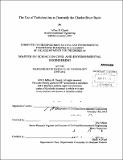The use of turbulent jets to destratify the Charles River Basin
Author(s)
Church, Jeffrey H. (Jeffrey Harrison)
DownloadFull printable version (7.868Mb)
Other Contributors
Massachusetts Institute of Technology. Dept. of Civil and Environmental Engineering.
Advisor
Eric Adams.
Terms of use
Metadata
Show full item recordAbstract
This study examines the feasibility of using turbulent jets to destratify the Lower Charles River Basin between the Longfellow and Craigie Bridges between Boston and Cambridge. The basin is currently filled with salt water that intrudes from the downstream dam and the resulting vertical density gradients inhibit mixing, leading to low levels of dissolved oxygen at depth. A physical model was scaled to a portion of this basin and salt water was used to create initial density profiles. Turbulent jets were introduced near the bottom at varying flow rates, discharge angles, and nozzle diameters, and a conductivity probe was used to document changes in salinity versus elevation and time. The effectiveness of the turbulent mixing was determined by comparing the change in water column potential energy over time, while efficiency was determined by comparing the change in potential energy versus the cumulative input of kinetic energy. The most effective arrangement provided a scaled mixing time of about a week to mix the basin. Since this is significantly shorter than the (annual) period over which stratification takes place, it is concluded that the turbulent jets would be an effective method to destratify the basin.
Description
Thesis (S.M.)--Massachusetts Institute of Technology, Dept. of Civil and Environmental Engineering, 2012. Page 74 blank. Cataloged from PDF version of thesis. Includes bibliographical references (p. 72-73).
Date issued
2012Department
Massachusetts Institute of Technology. Department of Civil and Environmental EngineeringPublisher
Massachusetts Institute of Technology
Keywords
Civil and Environmental Engineering.